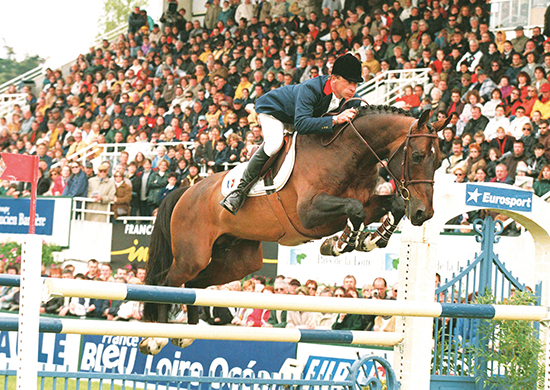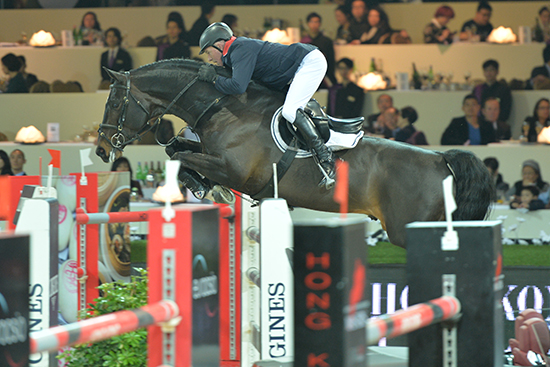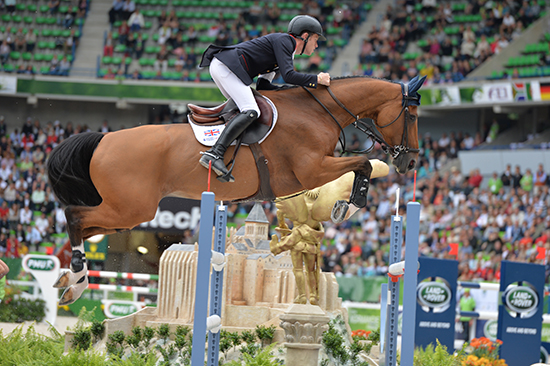Christopher Hector looks at the breeding of the jumpers who made it to the Final…
It comes as no surprise that Kannan was the dominating sire of the 2015 World Cup final – siring not only the winner, Albfuehren’s Paille (out of a Dollar du Murier mare) but also the third placed Molly Malone – this time out of a mare of solid Dutch breeding, Cavalier / Pion. Mr Blue also put two horses into the final top ten – Simon (out of a Polydox mare) and VDL Zirocco Blue NOP (out of a Voltaire mare). For Pleasure had two in the top 25 – Barron (Nabab de Rêve) was 9th and Coral Reef Follow Me (Sandro) 22nd.

Kannan
The old master, Contender continues to shine, siring Cool and Easy (Riverman), 18th, Carlo (Cascavelle), 13th , while his sons, Contango and Contendro were both represented in the world cup lineup.
I have always been something of a studbook snob, and looked down on mere registries as money-making exercises and the refuge for horses that couldn’t get papers anywhere else. As I learnt more and more of the imperfections of the Holy Grail of the ‘proper’ studbooks, the licensing / performance test routine I started to wonder. Many (most?) of the world’s very best sires were either failed at their licensing, or scored very badly in their performance tests, while many licensing winners, and for that matter performance test winners, turned out to be forgettable flops. Now the success of horses with the very fancy passports provided by the Anglo European Studbook gives more cause for re-consideration.
The AES is the studbook of choice for two of the horses at the top of the Hippomundo continuously updated world rankings. As I write: John Whitaker’s star stallion, Argento is 3rd, while Ben Maher’s top liner mare, Diva II (out of a mare by the Zeus son, Berlioz) is 12th. Others in the AES fold include, mare sensation, Bertram Allen’s Molly Malone (23rd on the rankings); Anton (by a second generation AES stallion, Marome MV out of a mare by another AES stallion, Orville ) who with Jaime Azcarraga won the AIG One Million Dollar in California, while Bertram Allen rode the AES approved stallion, Romanov (Heartbreaker) to win the Dortmund Grand Prix.
Argento
And before we get the letters from outraged AES members I do know the organization conducts stallion gradings etc, but it is still a private enterprise book with a wide open entry policy…
The somewhat checkered history of the organization is outlined in Celia Clarke’s recent article in Breeding News April 2015. She writes that the organization has been viewed with suspicion for a number of reasons including the name change from Anglo Dutch Breeders Association, the ‘capricious’ changes of location from England to Ireland and back again’, the ‘complete lack of a mare grading procedure’, an absence of a proper membership structure with the organization run as ‘pretty much a one man band’, and the tendency to run ‘private’ stallion gradings where the lack of results’ transparency often led to rather public criticism of the level of assessment involved.
After a series of legal wranglings in 2013, AES had underwent major changes, a new studbook manager, showjumper and breeder, Steve Lamb, was appointed along with a board lead by multi stallion owner, Kees van den Oetelaar, with his nephew, Joris as head of the stallion grading panel. According to Celia the signs of improvement, particularly in the area of stallion gradings, are good, although democracy would still seem fairly remote. “Joris and Steve are keen to stress that from now on anyone who buys a passport or registers a horse with them is a member of the AES, and that shortly all members will be receiving a regularly printed magazine to keep them informed of what is happening alongside the frequently updated website. A members’ meeting and an extensive consultation process with members to ensure that the studbook is fulfilling their needs and going in the right direction is also planned for later in the year.”
Does all this miss the point? Perhaps the organization’s great strength, and what has enabled it to flourish, is simply the ease with which papers can be purchased, and this open door has attracted some super talented horses that may have fallen between the cracks of the more rigid rules of the established books.
Right now AES sits at the top of the Hippomundo top ten studbook rankings, followed by Westfalia, SWB, sBs, Hannover, Holstein, Selle Français, Oldenburg and Oldenburg Jumping.
The other surprise in the studbook stakes has been the emergence of the traditionally smaller and less influential Belgian book, the sBs, currently in 4th place on the World standings, with Hello Sanctos (Quasimodo vd Molendreef / Quidam de Revel) In Las Vegas, the sBs was home to Penelope Leprevost’s Vagabond de la Pomme (Vigo d’Arsouilles / For Pleasure) in 2nd, as well as Lucy Davis’ Barron, 9th, and McLain Ward’s Rothchild (Artos / Elegant), 20th in the final standings. Currently the sBs stands in fourth place on the Hippomundo standings, with their rivals, and traditionally the dominating stud book of Belgium, the BWP, ranked 14th. However it might be noted that the sBs earnings of €2,055,737 come from 265 horses for an average of €7,757 – while the BWP’s 1186 horses, have earned €4,993,593 at an average of €4,210.
The sBs was founded in 1920 and is the oldest Belgian studbook. According to its rather smart website (www.sbsnet.be): “It aimed to encourage the breeding of horses mainly destined for the mounted Belgian Army… As of 1930, army and transportation are motorised, which reduces the outlets. At the same time, the Association changes name and becomes ‘the Belgian Half-Blood’, which promoted the breeding of a lighter saddle horse, which was more elegant by using sires closer to Thoroughbreds.”
“The second world war slows down and reduces the Society’s activities, although it continued to register foals… Adapting to the new circumstances, the requirements of the invader and the needs of the Belgian customers, the breeders start breeding carriage horses. The requisitions of the German army impoverishes the number and quality of the Belgian half-blood horses, and at the end of the second world war, only a few mares and some trotter stallions are left: it is therefore necessary to rebuild breeding farms and to improve the remaining ones, by stimulating the breeders to breed half-blood horses.”
“The interest in equestrian sports, as well in Belgium as abroad, pushes the breeders to improve their breeding (or to create new ones) by importing mares and stallions of quality, often of prominent origin (mainly French but also English, Irish, German…) and they finally formed the kernel of the breeding of the modern sports horse.”
“As a reward for the accomplished efforts and the obtained results after half a century of existence, our Association becomes ‘Royal Society’ in 1967.”
The sBs registers about 1000 foals a year. Like the BWP, and for that matter, the neighbouring ‘giant’, the KWPN, the sBs has a relatively open book, registering foals by stallions approved in other WBFSH recognized books. The sBs stallion ranks include Kannan, Nabab de Rêve, Kashmir van Schuttershof and Vigo d’Arsouilles. Indeed, the sBs proudly note that it was the first studbook to recognize these outstanding stallions, later other studbooks followed the sBs lead…
The results in Las Vegas produced no surprises in the sires stakes, but the new minute-by-minute standings, seem to be giving some of the lesser known studbooks their chance to shine with some rather surprising results.
This article originally appeared in the June 2015 issue of The Horse Magazine




